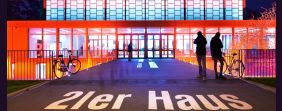Kategorien
- Ausstellungsdoku
- Dokumentation Performance
- Film und Video
- Künstler*innengespräch
- Neues
- Programm
- Veranstaltungen
Blick-Wechsel

73 views
0 favorites
 Lux, Stefan
Lux, Stefan
»In Seagull (2012) hielt der Künstler das fotografische Bild einer Möwe vor die Kamera, das aufgrund verschiedener Ablenkungen mehrfach aus dem Bildfeld rückte, um wieder manuell zentriert zu werden. Genau jene Sequenzen des Rejustierens wurden schließlich ausgewählt und montiert, um ein Bewegtbild zu schaffen, das den Eindruck einer Flugbewegung ohne Flügelschlag suggeriert. Die physische Handlung des Künstlers versetzt zunächst das statische Bild der Möwe in Bewegung. Die Videoaufzeichnung dokumentiert den performativen Akt, in dem sich der Körper des Filmemachers über die Bewegung des Fotos abzeichnet, um diese anschließend mittels Bildmontage in die Illusion einer Bewegung des im Bild Dargestellten zu überführen. Die (reale) Bewegung des Körpers des Künstlers trifft auf die (imaginierte) Bewegung der Möwe. Die dabei entstandenen unruhigen Bilder erscheinen als mediale "Fehlleistung", die aus der Konfrontation nicht nur zweier Bewegungen, sondern zweier Bewegungsmodi resultiert. Einerseits schafft Lux durch im Vorfeld festgelegte Parameter einen konzeptuellen Rahmen, innerhalb dessen seine Bewegungen ausgeführt werden, wobei gerade der Moment des Erkennens und Ausgleichens des eigenen körperlichen Versagens – das Rejustieren des Fotos – zum produktiven Moment wird und die eigentliche Arbeit teilweise konstituiert. Andererseits wird mittels der Montage eine Bewegung konstruiert, die eine als "natürlich" und "unbewusst" verstandene – jene der Möwe – imaginiert. In den bewegten Bildern erscheint dies als Durchkreuzung der "reinen" Bewegung des Künstlers und der repräsentativen der Möwe [7]. Bei Ersterer handelt es sich um eine Bewegung, die ausschließlich für die Kamera produziert wurde und außerhalb der in diesem Kontext festgelegten Parameter ohne jeden Nutzen ist. Zweitere hingegen imaginiert einen zweckorientierten Bewegungsmodus, der sowohl an dokumentarische Filmpraktiken im Kontext der Verhaltensforschung einer spezifischen Vogelart erinnert, als auch an frühe fotografische Bewegungsstudien bei Eadward Muybridge. Die Durchkreuzung erschließt sich allerdings erst im Moment der Rezeption und steht damit in Relation zum/zur Betrachter_in.«
»The basis of those of Lux’s works discussed here derives from more or less intentionally researched images taken from the internet. For Seagull (2012) the artist held a photographic image of a seagull in front of the camera. As a result of various distractions the image repeatedly dropped out of the frame only to be manually re-centred. It was exactly the readjustment sequences that were then chosen and edited together in order to create a moving image that gave the impression of the motion of flight without any actual wing-beats. It is the physical actions of the artist that set the static image of the seagull in motion. The video itself documents the performative act in which the body of the filmmaker is copied into the movement of the photo in order to be subsequently transposed (by editing) into an illusion that imparts movement to what is depicted in the picture. The (real) movement of the artist’s body encounters the (imaginary) movement of the seagull. The resulting restless images appear to consist of technical ‘mistakes’ that are not only the result of the confrontation between two movements but rather of two different movement modi. On the one hand Lux creates a conceptual framework with preset parameters within which his movements are to be carried out. In this context it is exactly the moment of recognising and compensating for physical failures––the readjustment of the photo––that become the productive moment that, in part, constitutes the actual work. On the other hand, movement is constructed by means of editing techniques. Although imaginary, that movement is taken to be the ‘natural’ and ‘unconscious’ movement of the seagull. In the moving images this appears as the ‘thwarted fable’ of the artist’s ‘pure’ movement and the representational movement of the seagull [7]. In the first case we are dealing with motion that has been produced solely for the camera and, outside of the preset parameters of this context, is of no practical import. In contrast, the second case imagines a practically-oriented modus of movement reminiscent of documentary practices in behavioural research into specific types of bird as well as calling to mind the early movement studies carried out by photographer Eadweard Muybridge. However, this intersection can only be grasped at the moment of reception and is thus situated in relation to the viewer.«
Mediale Gesten der Erschöpfung. Zu drei Videoarbeiten von Stefan Lux
Media-Mediated Gestures of Tiredness. Three Video Works by Stefan Lux
Bettina Brunner, 2013
[7] Deleuze, Das Zeit-Bild, S.248
© Stefan Lux
